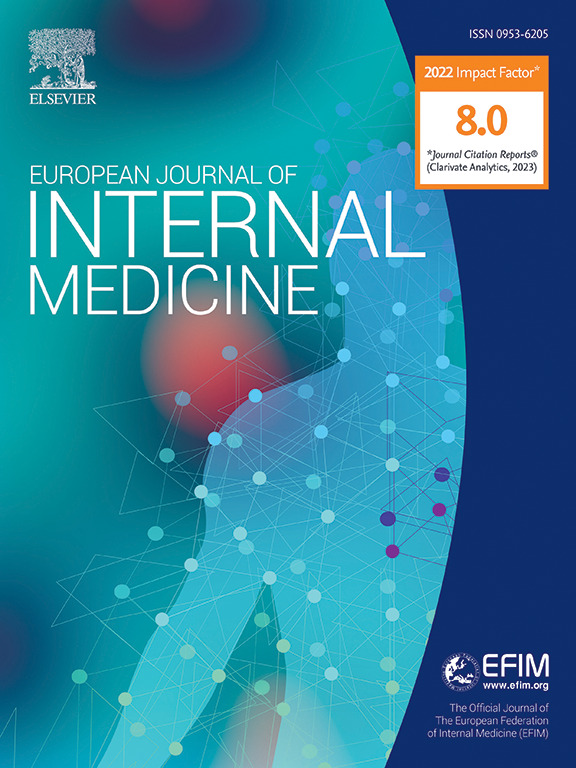欧洲社区获得性肺炎插管成人的治疗和结局的性别相关差异:一项多中心研究
IF 6.1
2区 医学
Q1 MEDICINE, GENERAL & INTERNAL
引用次数: 0
摘要
目的:探讨重症社区获得性肺炎患者预后的性别差异。方法:我们分析了来自9个欧洲国家的27个重症监护病房(ICU)的连续患者,并纳入了EU-VAP/CAP队列。严重CAP均予机械通气。性别从医疗记录中获取。根据年龄、疾病严重程度、慢性健康状况、合并症、诊断程序的使用、机械通气时间、在ICU的停留时间、初始抗生素治疗和病原体进行比较。主要终点是ICU死亡率。我们用多元逻辑回归检验了性别与死亡率的关系。结果:我们纳入了257例患者(32%为女性;平均年龄60.5岁)。SAPS II平均评分为48.6分,125例(50.6%)患者发生感染性休克,性别差异无统计学意义。女性的McCabe评分为0的情况较多(61%对51%的男性,p = 0.13)。39%的男性和26%的女性接受了支气管镜检查(p = 0.04)。抗生素治疗没有性别差异。在47%的患者中发现病原体。101例(39.3%)患者死亡:35%的男性和48%的女性(OR 0.59, 95% CI 0.34-1.00)。在调整年龄、SAPS II评分、McCabe评分和支气管镜检查使用后,男性与较低的死亡率相关(OR 0.42, 95% CI 0.21-0.84)。结论:重症CAP患者在ICU机械通气的死亡率较高,尽管病情严重程度相似,慢性健康状况较好。男性进行支气管镜检查的频率更高,这表明在处理方面存在性别差异。本文章由计算机程序翻译,如有差异,请以英文原文为准。
Sex-related differences in the management and outcome of intubated adults with community-acquired pneumonia in Europe: A multicentre study
Aims
To explore differences between sexes in the prognosis of severe community-acquired pneumonia.
Methods
We analysed consecutive patients admitted to 27 intensive care units (ICU) from nine European countries and included in the EU-VAP/CAP cohort. All were mechanically ventilated for severe CAP. Sex was obtained from the medical records. Sexes were compared according to age, severity of illness, chronic health condition, co-morbidities, use of diagnostic procedures, length of mechanical ventilation, stay in the ICU, initial antibiotic treatment, and pathogens. The primary outcome was ICU mortality. We tested in a multivariate logistic regression the association of sex with mortality.
Results
We included 257 patients (32 % women; mean age 60.5 years). Mean SAPS II score was 48.6 and 125 patients (50.6 %) were in septic shock, without difference between sexes. Women had more frequently a McCabe score of 0 (61 % vs. 51 % of men, p = 0.13).
Bronchoscopy was performed in 39 % of men and 26 % of women (p = 0.04). Antibiotic treatment did not differ between sexes. A pathogen was identified in 47 % of patients.
101 patients (39.3 %) died: 35 % of men and 48 % of women (OR 0.59, 95 % CI 0.34–1.00). Male sex was associated with lower mortality (OR 0.42, 95 % CI 0.21–0.84) after adjusting for age, SAPS II score, McCabe score, and use of bronchoscopy.
Conclusion
Women mechanically ventilated at the ICU for severe CAP had higher mortality despite similar severity of disease and better chronic health. Bronchoscopy was performed more frequently in men suggesting differences in management between sexes.
求助全文
通过发布文献求助,成功后即可免费获取论文全文。
去求助
来源期刊
CiteScore
9.60
自引率
6.20%
发文量
364
审稿时长
20 days
期刊介绍:
The European Journal of Internal Medicine serves as the official journal of the European Federation of Internal Medicine and is the primary scientific reference for European academic and non-academic internists. It is dedicated to advancing science and practice in internal medicine across Europe. The journal publishes original articles, editorials, reviews, internal medicine flashcards, and other relevant information in the field. Both translational medicine and clinical studies are emphasized. EJIM aspires to be a leading platform for excellent clinical studies, with a focus on enhancing the quality of healthcare in European hospitals.

 求助内容:
求助内容: 应助结果提醒方式:
应助结果提醒方式:


